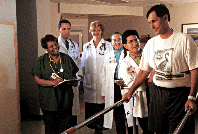Regaining Independence through Rehabilitation
 Patient Philip Montagno works on the parallel bars with Sam Perez, a
physical therapy technician, while members of his rehabilitation medicine team cheer his
progress; from left are nurse Linda Sandles, Dr. Edward Lord, Dr. Theresa Gillis and Dr.
Rebecca Clearman.
Patient Philip Montagno works on the parallel bars with Sam Perez, a
physical therapy technician, while members of his rehabilitation medicine team cheer his
progress; from left are nurse Linda Sandles, Dr. Edward Lord, Dr. Theresa Gillis and Dr.
Rebecca Clearman. "We want to help all patients regain their independence so they can
have a good quality of life for as long as possible."
"We want to help all patients regain their independence so they can
have a good quality of life for as long as possible."